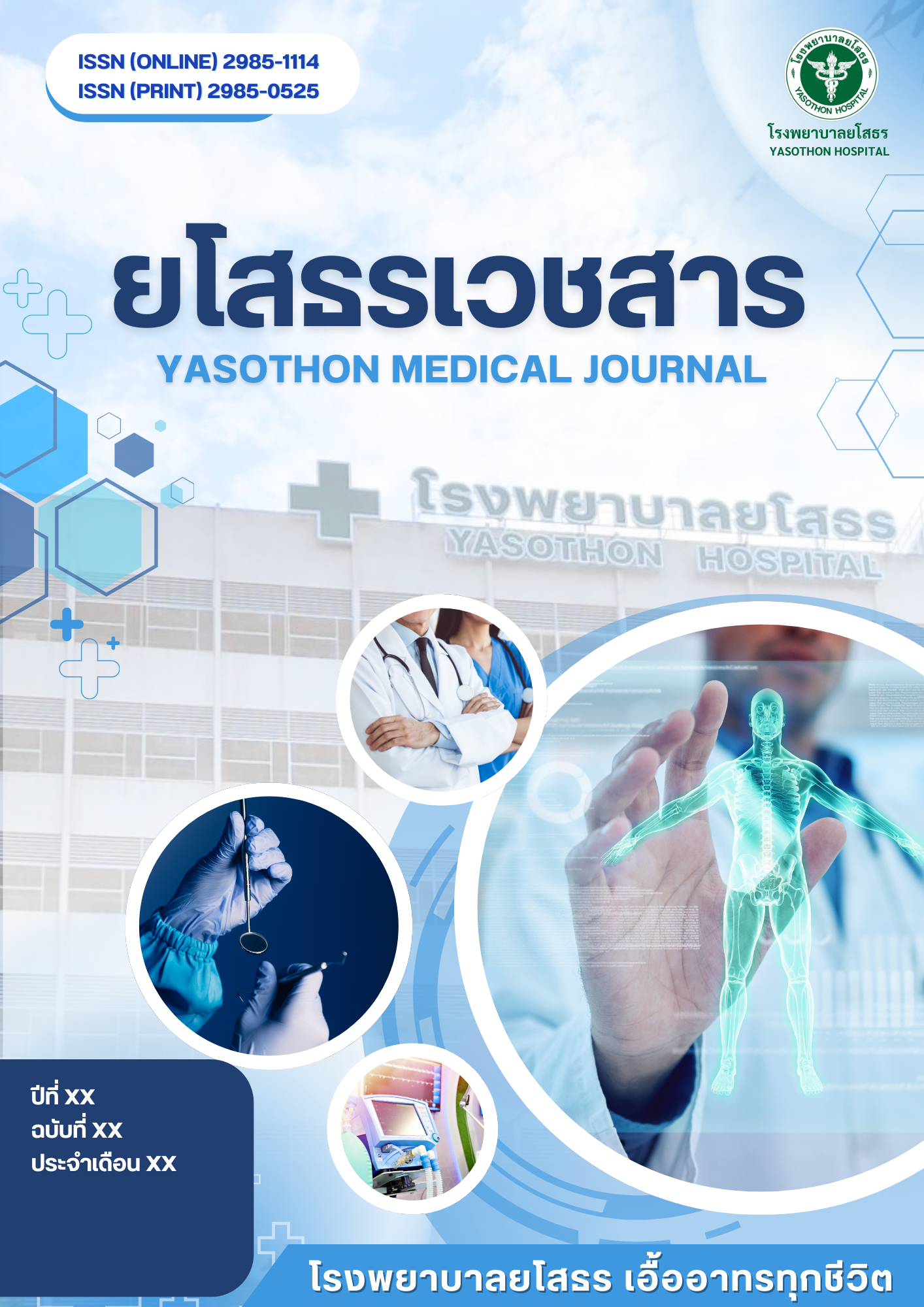Development of Nursing Practice Guidelines for Dengue Hemorrhagic Fever Pediatric Patients in Yasothon Hospital
Keywords:
Development of Nursing Practices, Dengue Hemorrhagic FeverAbstract
This research is a research and development. This research aims to develop and study the use of nursing practice guidelines for pediatric patients with dengue hemorrhagic fever at Yasothon Hospital. The sample group consisted of 2 groups: 1) service recipients, namely pediatric patients with dengue hemorrhagic fever aged 1 month - less than 15 years who were admitted to the pediatric ward, Yasothon Hospital between January and July 2022, totaling 30 patients; 2) service providers, namely 10 professional nurses. The research instruments included: 1) Guidelines for caring for pediatric patients with dengue hemorrhagic fever, 2) Pediatric Early Warning Signs (PEWS) Assessment Form. The data collection instruments included: 1) Dengue Hemorrhagic Fever Situation Analysis Record Form, 2) Personnel Satisfaction Questionnaire, and 3) Dengue Hemorrhagic Fever Nursing Practice Guidelines Compliance Record Form. There are 4 phases of the development process: 1) Situation survey phase, problem and need analysis of the development of a care model for pediatric patients with dengue hemorrhagic fever, 2) Model development and trial phase, 3) Guideline implementation, and 4) Summary and evaluation phase. Data were analyzed using frequency, percentage, mean, and standard deviation. Compare the differences using Pair t-test statistics.
The results of the study found that 1) Patient outcomes, namely shock, prolonged shock, and fluid overload, were significantly reduced at the .05 level. 2) Provider outcomes, namely overall satisfaction with nursing practices was high (= 4.75, S.D. = 0.26) and compliance with the guidelines for caring for children with dengue hemorrhagic fever at 96.49 percent.
Conclusion: The development of nursing practices for children with dengue hemorrhagic fever at Yasothon Hospital helped increase efficiency and competence in caring for children with dengue hemorrhagic fever to be safe, prevent severe complications, and reduce the rate of preventable complications, especially critically ill patients with severe complications, which can prevent death.
References
UNICEF. Dengue: How to keep children safe. Advice for families to protect against dengue [Internet]. 2023 [Cited 2025 Apr 18]. Available from: https://www.unicef.org/rosa/stories/dengue-how-keep-children-safe
กรุงเทพธุรกิจ. เฝ้าระวัง “โรคไข้เลือดออก” ปี 64 พบผู้ป่วย 7,720 ราย คาดปี 65 ระบาดรุนแรง [อินเทอร์เน็ต]. 2564 [เข้าถึงเมื่อ 18 เมษายน 2568]. เข้าถึงได้จาก: https://www.bangkokbiznews.com/social/966870
พึงเนตร สฤษดิ์นิรันดร์, ชารียา ธานี, ประภาพร ศรีชัยบาล, วันเพ็ญ เกณฑ์สาคู. ความยากลำบากในการรักษาผู้ป่วยเด็กไข้เลือดออกที่มีความรุนแรง. สรรพสิทธิเวชสาร มกราคม-ธันวาคม 2560; 38(1–3): 53–63.
กรมควบคุมโรค. สถานการณ์โรคติดต่อนำโดยยุงลายและการประเมินความเสี่ยงต่อการระบาดในปี 2564 [อินเทอร์เน็ต]. 2564 [เข้าถึงเมื่อ 18 เมษายน 2568]. เข้าถึงได้จาก: https://ddc.moph.go.th/uploads/publish/1212820211229113331.pdf
โรงพยาบาลยโสธร. สถิติอัตราการป่วยด้วยโรคไข้เลือดออก ประจำปี พ.ศ. 2564. ยโสธร: โรงพยาบาลยโสธร; 2565.
โรส ภักดีโต, จุไร อภัยจิรรัตน์, พัชมน อันโต. โรคไข้เลือดออกเดงกี่ในเด็ก: บทบาทสำคัญของพยาบาล. วารสารพยาบาลสภากาชาดไทย มกราคม-มิถุนายน 2560; 10(1): 55–65.
อรุณณี วงค์ปันดีด, ชัชวาล วงค์สารี, อาภรณ์ ศรีชัย. ความเหมือนที่แตกต่างในการพยาบาลผู้ป่วยโรคไข้เลือดออก: วัยเด็กและวัยผู้ใหญ่. วารสารวิชาการมหาวิทยาลัยอีสเทิร์นเอเชีย ฉบับวิทยาศาสตร์และเทคโนโลยี กันยายน-ธันวาคม 2561; 12(3): 124–32.
Monaghan A. Detecting and managing deterioration in children. Pediatr Nurs 2005; 17(1): 32-5. doi: 10.7748/paed2005.02.17.1.32.c964. PubMed PMID: 15751446.
Mandell IM, Bynum F, Marshall L, Bart R, Gold JI, Rubin S. Pediatric Early Warning Score and unplanned readmission to the pediatric intensive care unit. J Crit Care 2015; 30(5): 1090-5. doi: 10.1016/j.jcrc.2015.06.019. PubMed PMID: 26235654.
อนุวัฒน์ ศุภชุติกุล. เส้นทางสู่โรงพยาบาลคุณภาพ: คู่มือการเรียนรู้เชิงปฏิบัติ. กรุงเทพฯ: สถาบันพัฒนาและรับรองคุณภาพโรงพยาบาล; 2542.
Donabedian A. The quality of care: How can it be assessed? JAMA 1988; 260(12): 1743–8.
doi: 10.1001/jama.260.12.1743. PubMed PMID: 3045356.
The Joanna Briggs Institute. Reviewers' manual 2014 edition [Internet]. 2014 [Cited 2025 May 1]. Available from: http://joannabriggs.org/assets/docs/sumari/ReviewersManual-The-Systematic-Review-of-Economic-Evaluation-Evidence-2014_v2.pdf
Brouwers MC, Kho ME, Browman GP, Burgers JS, Cluzeau F, Feder G, et al. Appraisal of guideline for research & evaluation II; AGREE II [Internet]. 2017 [Cited 2025 May 1]. Available from: https://www.agreetrust.org/wp-content/uploads/2017/12/AGREE-II-Users-Manual-and-23-item-Instrument-2009-Update-2017.pdf
จารุพรรณ ตันอารีย์. ประสิทธิภาพการใช้ Pediatric Early Warning Score: PEWS ในหอผู้ป่วยกุมารเวชกรรม โรงพยาบาลกำแพงเพชร. วารสารกุมารเวชศาสตร์ กรกฎาคม-กันยายน 2559; 55(3): 196-219.
World Health Organization. Dengue: Guidelines for diagnosis, treatment, prevention and control. Geneva: WHO Press; 2009.
Downloads
Published
How to Cite
Issue
Section
License
Copyright (c) 2025 YASOTHON MEDICAL JOURNAL

This work is licensed under a Creative Commons Attribution-NonCommercial-NoDerivatives 4.0 International License.
บทความที่ได้รับการตีพิมพ์เป็นลิขสิทธิ์ของยโสธรเวชสาร







